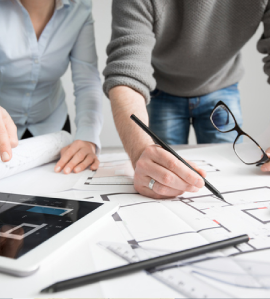One Size Doesn’t Fit All: Sustainability in a new home
When clients come to me already knowing they want sustainability in a new home, it’s not a conclusion; instead that’s where the conversation starts. That’s because sustainability is something people arrive at from different goals. It’s important for us to get at the goals and objectives that drive the request. It enables me to guide the clients and design a home that truly meets their needs.
Here are just some of the goals they might describe:
- A wish to reduce any negative impact (“carbon footprint”) on the
world and be a shining beacon for others. - As a marketing move or to win an award; especially in commercial buildings, a LEED building might be seen as adding interest.
- Or maybe a certification that costs $10,000+ doesn’t matter, but implementing the LEED strategies themselves does.
- Cost savings. It may cost more to design and build the structure, but less to operate it as a result. This is pocketbook green versus environmental green. (Though we try to get people off the cost button, to look more at long-term value.) Sustainability can also help with that; though “going green” environmentally does add time and money at the beginning.
- Others want to differentiate themselves or build a better world; they might say, “I’ll put my money upfront and let’s do it.”
- Health. For some, this is the priority, for themselves, their children, or their employees.
Understanding goals will help direct which solutions are best. This is what interests me about biophilic design. Biophilic design approaches the human and nature relationship from the opposite direction (asking, what is the impact of the environment on mankind?). It speaks to the symbiotic relationship and endears us to the world around us much more than “armchair sustainability” does. Our philosophy in the area of sustainability is that the environment can help you more than you are helping it. A project that gives attention to that two-way relationship, through the biophilic and the earth-friendly, is optimal.
When it comes to health, it’s important to get specific about what the concern is and what the problem is. It may be circadian rhythm, chemicals, or allergies. If it is a phobia or a sensitivity, there will be unique and specific challenges – and design solutions. An architect in this scenario is especially important because the builder grade, one-size-fits-most house no longer feels like a fit with these kinds of concerns.
If the interest in sustainability is more general, we can start by looking at exposure to natural light and good ventilation. Even this will require some problem-solving. Often, diffused light and avoidance of solar heat gain and glare are desired, too. Glazing, shades, and light reflected off of a “light shelf” will help.
Though we try to attend to sustainability with all clients and projects, we would look to specifically find out what your goals and objectives are so that the end result delights you and makes your life even better. Architecture is a problem-solving method that results in a solution. The process can vary, depending on the project and the problem. These strategies all work to gain sustainability in a new home, but for specific conditions. Design is the beginning, building is the middle, and operation is the next step.


